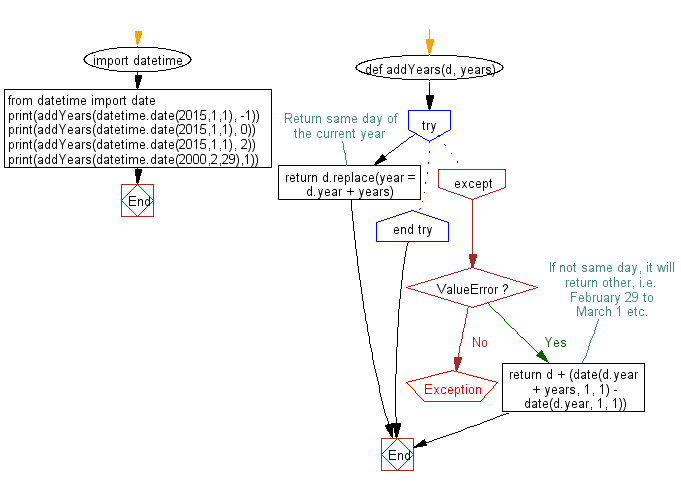Python: Add year(s) with a given date and display the new date
Python Datetime: Exercise-16 with Solution
Write a Python program to add year(s) with a given date and display the new date.
Sample Solution:
Python Code:
import datetime
from datetime import date
def addYears(d, years):
try:
#Return same day of the current year
return d.replace(year = d.year + years)
except ValueError:
#If not same day, it will return other, i.e. February 29 to March 1 etc.
return d + (date(d.year + years, 1, 1) - date(d.year, 1, 1))
print(addYears(datetime.date(2015,1,1), -1))
print(addYears(datetime.date(2015,1,1), 0))
print(addYears(datetime.date(2015,1,1), 2))
print(addYears(datetime.date(2000,2,29),1))
Sample Output:
2014-01-01 2015-01-01 2017-01-01 2001-03-01
Flowchart:

Python Code Editor:
Contribute your code and comments through Disqus.
Previous: Write a Python program to select all the Sundays of a specified year.
Next: Write a Python program to drop microseconds from datetime.
What is the difficulty level of this exercise?
Test your Programming skills with w3resource's quiz.
Python: Tips of the Day
Find current directory and file's directory:
To get the full path to the directory a Python file is contained in, write this in that file:
import os dir_path = os.path.dirname(os.path.realpath(__file__))
(Note that the incantation above won't work if you've already used os.chdir() to change your current working directory, since the value of the __file__ constant is relative to the current working directory and is not changed by an os.chdir() call.)
To get the current working directory use
import os cwd = os.getcwd()
Documentation references for the modules, constants and functions used above:
- The os and os.path modules.
- The __file__ constant
- os.path.realpath(path) (returns "the canonical path of the specified filename, eliminating any symbolic links encountered in the path")
- os.path.dirname(path) (returns "the directory name of pathname path")
- os.getcwd() (returns "a string representing the current working directory")
- os.chdir(path) ("change the current working directory to path")
Ref: https://bit.ly/3fy0R6m
- New Content published on w3resource:
- HTML-CSS Practical: Exercises, Practice, Solution
- Java Regular Expression: Exercises, Practice, Solution
- Scala Programming Exercises, Practice, Solution
- Python Itertools exercises
- Python Numpy exercises
- Python GeoPy Package exercises
- Python Pandas exercises
- Python nltk exercises
- Python BeautifulSoup exercises
- Form Template
- Composer - PHP Package Manager
- PHPUnit - PHP Testing
- Laravel - PHP Framework
- Angular - JavaScript Framework
- Vue - JavaScript Framework
- Jest - JavaScript Testing Framework
